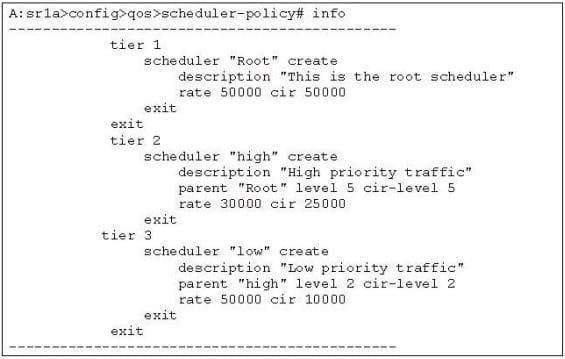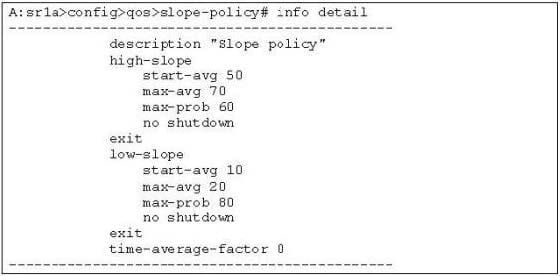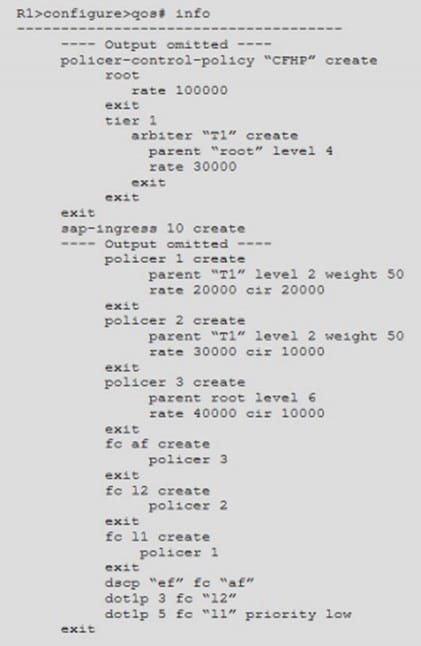4A0-107 Online Practice Questions and Answers
What is an SLA? (Choose two)
A. An SLA is used to provide automated, real-time testing and alarming for throughput, latency, and jitter across a provider's network.
B. An SLA is an agreement between a customer and a provider that dictates the treatment of customer traffic across the provider's network.
C. An SLA allows customers to control all traffic within the service provider's network by prioritizing their traffic over others as desired.
D. An SLA allows a customer to pre-mark traffic and ensure that traffic is treated as per the agreement within the provider's network.
E. An SLA is a standard set of network QoS policies that a provider shares to all its customers, allowing them to better understand the treatment of traffic within the provider's network.
What is the maximum number of SAP-ingress policies that can be applied on a SAP?
A. 1
B. 2
C. 3
D. 4
E. 5
F. 8
How many queues are available for use on service egress within a VPLS service?
A. 1 multipoint and 8 unicast.
B. 8 queues, regardless of traffic type.
C. 8 unicast and 24 multipoint.
D. 8 unicast and 8 multipoint.
E. 16 queues, distributed as desired.
Which of the following entities can scheduler policies be applied to? (Choose two)
A. Network ingress port
B. Epipe ingress SAP
C. ES egress SAP
D. Ingress MDA
E. VPRN ingress interface
F. Shared buffer space
Policing improves bandwidth utilization by using buffering to absorb high bursts of traffic.
A. TRUE
B. FALSE
Which of the following statements BEST describes where shaping mechanisms should be applied?
A. On all ports on the Nokia 7750 SR.
B. At the junction of high-speed to low-speed links or at places of traffic aggregation.
C. At the junction of low-speed to high-speed links or at places of traffic aggregation.
D. On low-speed WAN links.
E. Nowhere. Shaping is only performed in hardware and serviced in a round-robin.
Click the exhibit button below. Given this scheduler-policy configuration, which of the following can be said about the scheduler called "high"? (Choose two)

A. It is a parent scheduler.
B. It is the top-level scheduler.
C. It can allocate up to 50 Mbps of bandwidth to scheduler "low" since the bandwidth is not used by another Tier 3 scheduler.
D. It is a child scheduler.
E. It can only have queues as children.
Click the exhibit button below. Given that the slope-policy (below) has been enabled and applied on a network port, which of the following statements are TRUE? (Choose three)

A. All out-of-profile traffic will be dropped before any in-profile is dropped.
B. The time average factor of 0 will discard all packets arriving in the shared buffer pool.
C. When the shared buffer utilization reaches 51%, in-profile packets might be dropped.
D. The highest probability with which an out-of-profile packet can be dropped is 20%.
E. When an in-profile packet arrives and the shared buffer utilization is at 69%, the packet will have approximately a 60% likelihood of being discarded.
Which of the following parameters are used in a hierarchical scheduler-policy to specify the priority of the child scheduler/queue for allocating bandwidth beyond its committed rate? (Choose two)
A. CIR
B. CIR level
C. CIR weight
D. Rate
E. Level
F. Weight
Which of the following statements regarding the default scheduler in the Nokia 7750 SR are TRUE? (Choose two)
A. There are a maximum of 8 levels of priority serviced using a round-robin algorithm.
B. The default scheduler will spend an equal amount of time in each queue, as long as there is traffic present
C. The H1 internal forwarding class will receive its CIR before AF traffic.
D. Orphaned queues will be scheduled out of the BE queue.
E. A queue servicing EF and AF traffic will require explicit configuration to set the queue to expedited.
Which of the following statements about the DiffServ and IntServ QoS models is FALSE?
A. IntServ uses a protocol like RSVP to provide QoS guarantees on a per-flow basis.
B. DiffServ groups multiple microflows into bigger streams called macro flows.
C. Intserv requires that network routers allocate resources for thousands of individual flows.
D. Diffserv classifies packets into forwarding classes only at the first network hop.
Which of the following policies does NOT exist by default on a network port?
A. A network policy for every network interface configured on the port.
B. A slope policy for the port on ingress.
C. A network queue policy for the corresponding MDA on ingress.
D. A network queue policy for the port on egress.
Which of the following statements about configuring queues to use shared or reserved buffer space is FALSE?
A. When queues use shared buffer space, buffers are more efficiently utilized.
B. Queues that use reserved buffer space will have memory available for their reserved portion.
C. When a queue is not using its reserved portion, other queues can use it.
D. Using reserved buffer space prevents a queue from being starved of buffer resources by other queues.
Both SAP-ingress 10 and policer-control-policy "CFHP" have been applied to a service SAP ingress. What is the maximum bandwidth allocated to policer 2?

A. 10000 Kbps
B. 15000 Kbps
C. 20000 Kbps
D. 30000 Kbps
Which of the following is an example of something that CAN be done with hierarchical policing (CFHP) but CANNOT be done with standalone policers?
A. Limiting the maximum forwarding rate of each individual policer and, at the same time, marking, packets as in-profile or out-of-profile.
B. Putting packets in a buffer as they are received, and marking packets as in-profile or out-of-profile as they are removed from the buffer.
C. Rate-limiting the collective output of several policers, and to reallocate bandwidth that is not utilized by some policers to other policers that need to use it.
D. Rate-limiting the collective output of several policers towards each egress FFPC, while maintaining control of the maximum overall forwarding rate.
